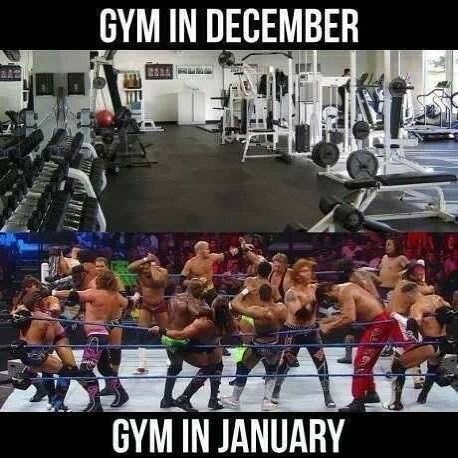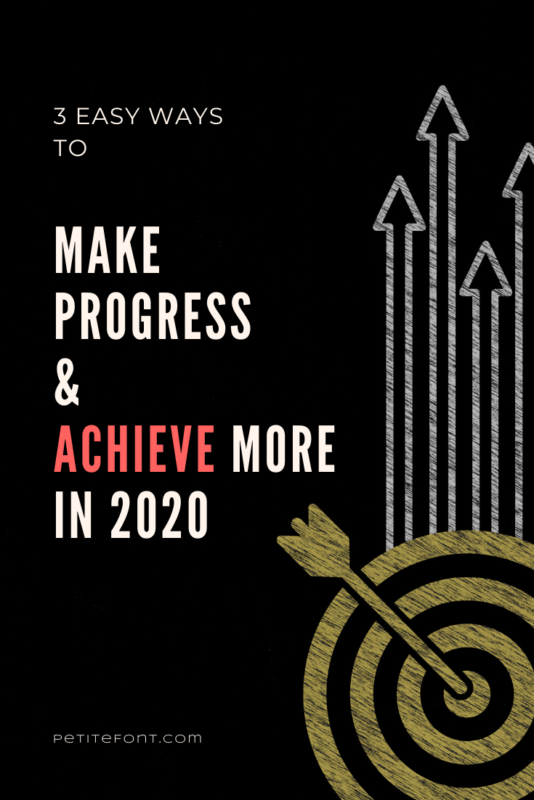
Are you setting goals for 2020? Have you thought that far ahead yet? Or did you have a list ready in-hand when the clock magically struck midnight on January 1st?
It’s funny that a lot of people hate the idea of “new year resolutions,” but get excited about goal setting. Because they’re the same thing. One is just tied to a particular date that the entire world seems to celebrate.
This bashing of resolutions is probably in part due to that ubiquitously vague one that is so prevalent it’s now a meme:

Fitness-based resolutions are popular. So is hating on fitness-based resolutions. Don’t want to have one? Cool, don’t feel compelled to. If you do? Don’t be embarrassed to want it.
Do YOU.
The important thing about goals, whether or not they be set around the new year, is that they are about YOU. Your goals are for you, not your friends. Setting goals is about making a better YOU. That could lead to you being a better friend, partner, parent, boss, etc. But the person who is important here is YOU.
Conversely, other people’s interests in changing themselves are NOT a commentary on YOU. If your friend wants to lose weight but you’re comfortable in your body, then that’s perfectly okay. Your friend is not a bad person for wanting to better themselves in that way and you are not a bad person for loving yourself just as you are. Just support each other!
But first, how do you set your own goals?
*Housekeeping: please note that I received this pattern for free as a member of the Sew My Style 2020 team. All opinions are my own.*
Before Setting Goals for 2020
There are 3 things to be aware of when setting up your goals.
The first thing to note is that goals for the year can start AT ANY TIME. New Year’s resolutions are great. But if you don’t want to make changes until February, or July, or your next birthday, that’s fine. You’ll make the changes when you’re ready and willing to do it.
The second thing is to stop worrying about failing at your goals. Failure isn’t the end of the road. It’s merely “course correction.” If you don’t reach your goal down one path, try a different approach.
Third, look for support. Changes are always easier to make when you’re supported by your people. Will your partner or family offer it? What about joining a meetup or Facebook group around your particular goal? Look around to see what support might look like for you.
Now we’re ready to start!
Setting Goals for 2020: Method 1
So what is it you want to do? Be as specific as possible. Because the smaller and better defined goals are, the easier they become to accomplish!
For example, if you simply want to be less stressed, what does that really mean? What stresses you out? Is it work, family, the commute, a combination of all three, something completely different? Which one of these is the easiest to tackle?
If you do have a fitness-related goal, is it that you actually want to lose weight, or do you have a different goal? Maybe you want to simply improve your diet, or sleep more.
Let’s get specific with all of these.
If we’re dealing with a particular stressor, like the 6 pm commute in traffic, what are some things about the commute that you can change?
- Would leaving later improve the drive time? Is changing your schedule to accommodate that possible?
- If not, can you listen to something soothing that will turn your car into an oasis? For some people that’s podcasts or audiobooks. For others, it’s blasting death metal music for their own private concert.
- Can you forgo a commute on certain days and tele-commute instead?
If your goal is to sleep more or better, what are some changes you could make to improve sleep?
- Does that mean limiting caffeine to a different time of day?
- Exercising at night to tire you out before bed?
- Meditating as you fall asleep instead of playing with a mobile device
- Starting the “go to sleep” process 30 minutes earlier in the day?
Or do you want to improve how you eat?
- Do start by limiting your soda intake?
- Or adding one more fruit or vegetable to your daily meals?
- Leaving the alcohol for weekends?
- Switching to a paleo/keto/vegan/etc diet?
I am pulling from my own experiences with each of these examples.
I once had a 2-hour commute in a car with manual transmission. To add insult to injury, I was staring directly at the sun in both directions. I only had to do this for 6 months but I seriously thought I would lose my shit sooner than that if something didn’t change. Finally I found solace in audiobooks. They allowed me to still concentrate on the road, but helped me forget that I was riding my clutch the entire time and never really getting out of 1st gear.
I finished 18 books in that time period. And wasn’t a stark raving bitch when I got home from work most of the time either.
To get better sleep, I’ve started ignoring my phone. As much as I like to decompress by playing Two Dots at night, I’ve found that I really do sleep better if I just…don’t.
Instead I write in my gratitude journal (yup, I do that too), talk to my husband a little bit, and then meditate while doing some breathing exercises. I know it all sounds hokey and silly. But it’s worked for me.
I’m still working on sleeping longer (I wake up an hour earlier than I wish I did), but the overall quality of my sleep is better. I have fewer nightmares now, too.
With diet, I’ve simply started eating more vegetables. That’s really it: just having more fiber is fantastic! But I concentrate on vegetables I like, not just the ones I “should” eat. Like kale and Brussels sprouts. I’m never going to make those palatable, so I don’t even try.
Our household motto is Fuck Kale.
Instead I roast a bunch of stuff I do like at the beginning of the week to make sure I have a variety to choose from at every meal. Sweet potatoes are my favorite because they taste like squishy pieces of candy. But they’re full of Vitamin A and other good stuff. Zucchini, Chinese eggplant, spaghetti squash, mushrooms, and cauliflower are other staples.
I also really love steamed spinach, so I have a handful of that with almost everything. It’s fun to stuff a bowl full of it, microwave it for 15 seconds, and watch it disappear! This steaming technique also removes the “hairy teeth” feeling raw spinach can give you.
And as much as I LOVE beer (I drink and I sew things, after all!), I’ve limited my alcohol intake to strictly weekends. The husband and I have also started planning date night activities that don’t revolve around exploring new breweries. It’s one of our favorite things to do, especially when traveling. But since we’re home for the next long stretch, we can explore something different. Like art galleries. We live right smack in the middle of the East Village, which has a ton of art!
After a little while, all these tiny things you’re doing towards a bigger goal start to add up! Before long, you create new habits that start to replace the behavior or stressor you were trying to fix.
Ruth Soukup of the Do It Scared podcast has a great short episode on this very topic. It’s an 11-minute quickie called How to Stick to a New Routine. She talks about habit building and a lot of what I covered above. I actually just heard it this very morning and highly recommend it!
Setting Goals for 2020: Method 2
I have a much more specific fitness-related goal for this year, too. I want to be able to deadlift 315 pounds. So in figuring out how to accomplish that, I’ve set up a path to reach it.
That’s called a SMART goal: Specific, Measurable, Achievable, Relevant, and Time-bound.
- Specific: I want to deadlift 315 pounds (143 kg)
- Measurable: measure in pounds and reps using progressive overload
- Achievable: I can currently deadlift up to 255 pounds (116 kg)
- Relevant: I am a dedicated weight lifter already and this will be around 1.75x my bodyweight when it happens
- Time-bound: by the end of 2020
I’ll talk more about why this exact number is important to me in the next post. This is simply an illustration of how to use the SMART method.
This approach is hugely popular in corporate settings and HR. I’ve used it a lot with employees and volunteer groups. In fact, when looking for resources for SMART goals, I came across this PDF from the University of California (which, as a UCLA grad, I have a special place in my heart for!). SMART Goals: A How To Guide. Anyone can download it!
So if your goals can be defined this way, then they can also be easily measured! Ruth talks about this in the podcast above.
Measuring means tracking changes. Remember what I said about failure? If something isn’t working, you need to know! So you can change course and correct it!
Setting Goals for 2020: Method 3
I recently started reading Simple Abundance by Sarah Ban Breathnach.
In the book, Sarah insists on you using a gratitude journal (which is why I described it above). The mere act of consciously writing down 5 things every day that you’re grateful for is supposed to lead to an awakening. An appreciation for what you have. And in time, the more you will have.
If your goal is to stop craving more, opt out of the rat race, reach contentment, strive for minimalism, or what-have-you, wouldn’t a great way to start be to create a list of what you already have? Start from abundance. You are richer than you recognize.
Gratitude. It shifts your focus from wishing for more to appreciating what is already in front of you.
That’s a goal that doesn’t require specific or measureable metrics. Sure, you need to come up with 5 things every day. But they don’t have to be 5 new things. You can be grateful for the same 5 things every single day.
And maybe what you become grateful for is having new habits, breaking bad ones, solving a stressful problem, or creating a SMART goal!
So that’s 3 different ways to go about setting goals for 2020. Do you have some for yourself this year? Share in the comments if you’re comfortable!
And pin it for later, gator!







